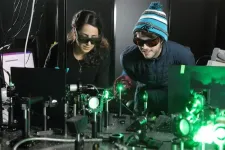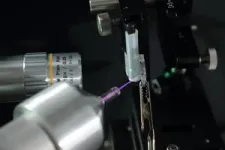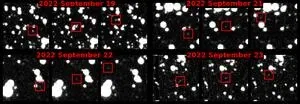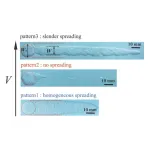(Press-News.org) You know that freeze-ray gun that “Batman” villain Mr. Freeze uses to “ice” his enemies? A University of Virginia professor thinks he may have figured out how to make one in real life.
The discovery – which, unexpectedly, relies on heat-generating plasma – is not meant for weaponry, however. Mechanical and aerospace engineering professor Patrick Hopkins wants to create on-demand surface cooling for electronics inside spacecraft and high-altitude jets.
“That’s the primary problem right now,” Hopkins said. “A lot of electronics on board heat up, but they have no way to cool down.”
The U.S. Air Force likes the prospect of a freeze ray enough that it has granted the professor’s ExSiTE Lab (Experiments and Simulations in Thermal Engineering) $750,000 over three years to study how to maximize the technology.
From there, the lab will partner with Hopkins’ UVA spinout company, Laser Thermal, for the fabrication of a prototype device.
The professor explained that, on Earth – or in the air closer to it – the electronics in military craft can often be cooled by nature. The Navy, for example, uses ocean water as part of its liquid cooling systems. And closer to the ground, the air is dense enough to help keep aircraft components chilled.
However, “With the Air Force and Space Force, you’re in space, which is a vacuum, or you’re in the upper atmosphere, where there’s very little air that can cool,” he said. “So what happens is your electronics keep getting hotter and hotter and hotter. And you can’t bring a payload of coolant onboard because that’s going to increase the weight, and you lose efficiency.”
Hopkins believes he’s on track toward a lightweight solution. He and collaborators recently published a review article about this and other prospects for the technology in the journal ACS Nano.
The Fourth State of Matter
The matter we encounter every day exists in three states: solid, liquid and gas. But there’s a fourth state: plasma. While it may seem relatively rare to us on Earth, plasma is the most common form of matter in the universe. In fact, it’s the stuff that stars are made of.
Plasmas can occur when gas is energized, Hopkins said. That powers their unique properties, which vary based on the type of gas and other conditions. But what unites all plasma is an initial chemical reaction that untethers electrons from their nuclear orbits and releases a flow of photons, ions and electrons, among other energetic species.
The eye-popping results can be witnessed in the sudden flash of a lightning strike, for example, or the warm glow of a neon sign.
Though plasma screen televisions were once a thing, then phased out, don’t let that fool you. Plasma is increasingly being used in technology. It’s already utilized in the engines of many of the Air Force’s speediest jets. The plasma assists combustion, improving speed and efficiency.
But Hopkins pictures plasma also being used in the interior of the craft.
The typical solution for air and space electronics has been a “cold plate,” which conducts heat away from the electronics toward radiators, which release it. For advanced electronics, however, that may not always be sufficient.
Hopkins thinks the revised setup may be something like a robotic arm that roves in response to temperature changes, with a short, close-up electrode that zaps hot spots.
“This plasma jet is like a laser beam; it’s like a lightning bolt,” Hopkins said. “It can be extremely localized.”
The Plasma Enigma
Cool fact: Plasma can reach temperatures as hot as the surface of the sun. But it also seems to have this weird characteristic – one that would appear to violate the second law of thermodynamics. When it strikes a surface, it actually chills before heating.
Hopkins and his collaborator, Scott Walton of the U.S. Navy Research Laboratory, made the unexpected discovery several years ago, just before the pandemic hit.
“What I specialize in is doing really, really fast and really, really small measurements of temperature,” Hopkins said of his custom-made microscopic instruments, which can record specialized heat registries.
In their experiment, they fired a purple jet of plasma generated from helium through a hollow needle encased in ceramic. The target was a gold-plated surface. The researchers chose gold because it’s inert, and as much as possible, they wanted to avoid surface etching by the focused beam, which could skew the results.
“So when we turned on the plasma,” Hopkins said, “we could measure temperature immediately where the plasma hit, then we could see how the surface changed. We saw the surface cool first, then it would heat up.
“We were just puzzled at some level about why this was happening, because it kept happening over and over. And there was no information for us to pull from because no prior literature has been able to measure the temperature change with the precision that we have. No one’s been able to do it so quickly.”
What They Realized
What they finally determined, in association with then-UVA doctoral researcher John Tomko and continued testing with the Navy lab, was that the surface cooling must have been the result of blasting an ultrathin, hard-to-see surface layer, composed of carbon and water molecules.
A similar process happens when cool water evaporates off of our skin after a swim.
“Evaporation of water molecules on the body requires energy; it takes energy from body, and that’s why you feel cold,” the professor said. “In this case, the plasma rips off the absorbed species, energy is released, and that’s what cools.”
Hopkins’ microscopes work by a process called “time-resolved optical thermometry” and measure something called “thermoreflectance.”
Basically, when the surface material is hotter, it reflects light differently than when it’s colder. The specialized scope is needed because the plasma would otherwise obliterate any directly touching temperature gauges.
So how cold is cold? They determined they were able to reduce the temperature by several degrees, and for a few microseconds. While that may not seem dramatic, it’s enough to make a difference in some electronic devices.
After the pandemic delay, Hopkins and collaborators published their initial findings in Nature Communications last year.
Then the question became: Could they get a reaction to be colder and last longer?
Refining the Freeze Ray
Previously working with the Navy’s borrowed equipment – so lightweight and safe it was often used for school demonstrations – the UVA lab now has its own setup, thanks to the Air Force grant.
The team is looking at how variations on their original design might improve the apparatus. Doctoral candidates Sara Makarem Hoseini and Daniel Hirt are considering gases, metals and surface coatings that the plasma can target.
Hirt provided a lab update.
“We haven’t really explored the use of different gasses yet, as we’re still working with helium,” he said. “We have experimented so far with different metals, such as gold and copper, and semiconductors, and each material offers its own playground for investigating how plasma interacts with their different properties.
“Since the plasma is composed of a variety of different particles, changing the type of gas used will allow us to see how each one of these particles impact material properties.”
Hirt said working with Hopkins on a project with such significant implications has rejuvenated his interest in research, in large part due to the supportive lab environment the professor fosters.
“I feel like it’s night and day comparing not only where I was as a scientist, but also my enjoyment of science, to where I am today,” he said.
END
Way cool: UVA professor developing ‘freeze ray’ technology for the Air Force
2023-07-31
ELSE PRESS RELEASES FROM THIS DATE:
Bees likely evolved from ancient supercontinent, earlier than suspected
2023-07-31
PULLMAN, Wash. –The origin of bees is tens of millions of years older than most previous estimates, a new study shows.
A team led by Washington State University researchers traced the bee genealogy back more than 120 million years to an ancient supercontinent, Gondwana, which included today’s continents of Africa and South America.
In a study that proposes a new evolutionary history of bees, the researchers found evidence that bees originated earlier, diversified faster and spread wider than many scientists previously suspected. They published their findings in the journal Current ...
Routinely drinking alcohol may raise blood pressure even in adults without hypertension
2023-07-31
Research Highlights:
An analysis of data from seven studies involving more than 19,000 adults in the United States, Korea and Japan found a clear association between increases in systolic (top-number) blood pressure and the number of alcoholic beverages consumed daily.
Even people who drank one alcoholic beverage per day showed a link to higher blood pressure when compared to non-drinkers, reinforcing the American Heart Association’s advice to limit alcohol intake and to not start drinking alcohol if you do not already.
Embargoed until ...
This disease can be caused by a food allergy and prevent children from eating. A new study may show how to treat it
2023-07-31
A new study from Tulane University has identified a new treatment for a chronic immune system disease that can prevent children from eating.
Eosinophilic esophagitis (EoE) is triggered by food allergies or airborne allergens which causes a type of white blood cell, eosinophils, to build up in the lining of the esophagus. This causes the esophagus to shorten and the esophageal wall to thicken, making swallowing difficult and causing food to get stuck in the throat.
The disease occurs in an estimated 1 in 2,000 adults but more frequently affects children (1 in 1,500) where symptoms can be harder to diagnose and pose greater risks as difficulty feeding can lead to malnutrition, weight loss and ...
Oxycodone prescriptions after delivery not linked to longer-term opioid use compared to codeine prescriptions
2023-07-31
Postpartum prescriptions for oxycodone were not associated with increased risk of longer-term opioid use compared to codeine prescriptions, according to new research published in CMAJ (Canadian Medical Association Journal) https://www.cmaj.ca/lookup/doi/10.1503/cmaj.221351.
Over the last 10 years, there has been a shift to fewer codeine prescriptions and an increase in prescriptions for stronger opioids, such as hydrocodone, hydromorphone and oxycodone for patients postpartum.
“This occurred in part ...
Novel vaccine may hold key to prevent or reduce the impact of Alzheimer’s disease
2023-07-30
Research Highlights:
A novel vaccine that targets a protein involved in Alzheimer’s disease helped eliminate toxic cells in mice with the condition.
After vaccination, the mice had fewer amyloid plaques and less inflammation in brain tissue and showed improvement in behavior and awareness.
Embargoed until 12 p.m. CT/1 p.m. ET, Sunday, July 30, 2023
BOSTON, July 30, 2023 — A novel vaccine that targets inflamed brain cells associated with Alzheimer’s disease may hold the key to potentially preventing or modifying the course of the disease, according to preliminary research presented at the American Heart Association’s Basic Cardiovascular Sciences Scientific ...
To spread or slide? Scientists uncover how foams are spread on surfaces
2023-07-29
Tokyo, Japan – Researchers from Tokyo Metropolitan University have uncovered the physics behind how foams are spread on surfaces. Balls of foam placed on a flat substrate were scraped across with a plate and observed. They identified different patterns which strongly depend on the scraping speed, governed by competing physical phenomena. Their findings apply to all kinds of soft materials that need to be spread evenly on surfaces, from mayonnaise on bread to insulation on walls.
Whether ...
How to save the NHS – an expert prescription
2023-07-29
Whether it’s setting up a Bank of England-type body to run it or fining patients for missing appointments, healthcare leaders, policymakers and practitioners past and present have a wealth of ideas about how they would change the NHS for the better.
Professor Dinesh Bhugra, a psychiatrist and former president of the British Medical Association and the Royal College of Psychologists, asked 14 peers, physicians and patients’ representatives for their prescription for the NHS.
The interviews are reproduced in Professor Bhugra’s new book, Conversations about the NHS. Thought-provoking and in some cases, controversial, ideas include:
Setting ...
Unlocking a mystery of fetal development
2023-07-28
As with many toxins, exposure to the toxic metal cadmium during pregnancy can adversely impact fetal development. Now, researchers at the Rutgers School of Public Health think they’re beginning to understand how the metal inflicts its damage: by disrupting placental hormones that regulate pregnancy physiology.
Unlike other toxins, relatively little cadmium crosses the placenta to directly impact the fetus. Instead, the placenta concentrates cadmium in its tissue at rates of up to six times that found in umbilical cord serum.
“We already know a lot about cadmium and its detrimental impacts on fetal health, such ...
How breast milk boosts the brain
2023-07-28
A new study by scientists at the Jean Mayer USDA Human Nutrition Research Center on Aging (HNRCA) at Tufts University suggests that a micronutrient in human breast milk provides significant benefit to the developing brains of newborns, a finding that further illuminates the link between nutrition and brain health and could help improve infant formulas used in circumstances when breastfeeding isn’t possible.
The study, published July 11 in the Proceedings of the National Academy of Sciences (PNAS), also paves the way to study what role this micronutrient might play in the brain as ...
New study findings underscore the importance of timely newborn screenings in early care for cystic fibrosis
2023-07-28
Aurora, Colo. (July 28, 2023) – The Journal of Pediatrics has published a manuscript by Stacey Martiniano, MD, pulmonary specialist at Children’s Hospital Colorado and associate professor of pediatrics at the University of Colorado. Dr. Martiniano was primary author on the study titled, Late Diagnosis in the Era of Universal Newborn Screening Negatively Effects Short- and Long-Term Growth and Health Outcomes in Infants with Cystic Fibrosis. The manuscript’s senior author was Susanna McColley, MD, professor of pediatrics in pulmonary and sleep medicine at Northwestern University Feinberg ...





